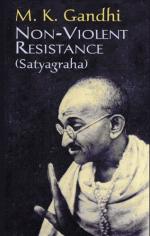|
This section contains 701 words (approx. 2 pages at 400 words per page) |

|
Section Ninth: Miscellaneous Summary and Analysis
This chapter contains various reflections of importance but that are not tied together by a single theme. Gandhi first claims that fasting can be understood as a form of penance for sin and he gives an example of his own penance. He goes on a seven-day fast due to an error in the conduct of his Ashram children. He then distinguishes true and false Satyagraha. Satyagraha cannot be pursued out of personal gain or it will not be successful. The Satyagrahi must not resist for himself or to hurt an opponent; he must resist rather for the common good.
Next Gandhi emphasizes the inportance of fasting as part of Satyagraha and as prayer. He denies that fasting is coercive despite trying to alter the behavior of others. However, he also emphasizes that fasting should only be pursued...
(read more from the Section Ninth: Miscellaneous Summary)
|
This section contains 701 words (approx. 2 pages at 400 words per page) |

|




